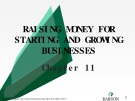
Social entrepreneurship coverage
-
Since 2017, social entrepreneurial intentions are a rapidly growing field of research. The research to explain the formation of intent to establish social enterprises be approached from many aspects, as well as based on different theoretical backgrounds. However, a large part of this study lacked systematization and classifications, and there seems to be a tendency to start anew with every study.
 17p
17p  trinhthamhodang11
trinhthamhodang11
 04-05-2021
04-05-2021
 18
18
 1
1
 Download
Download
-
Chapter 1 - The power of entrepreneurship. Chapter 1 discusses the role of entrepreneurship in the U.S. economy and looks at the entrepreneurial competitiveness of nations throughout the world.
 21p
21p  koxih_kothogmih6
koxih_kothogmih6
 23-09-2020
23-09-2020
 14
14
 1
1
 Download
Download
-
Chapter 8 - The business planning process. The goal of this chapter is to give you an introduction to entrepreneurial financial planning. Unlike in existing businesses, which have an operating history, entrepreneurs must develop their financials from scratch. There are no previous trends in revenue and costs that you can use as a basis to project future revenues and costs.
 11p
11p  koxih_kothogmih6
koxih_kothogmih6
 23-09-2020
23-09-2020
 22
22
 1
1
 Download
Download
-
Chapter 15 - Social entrepreneurship. Chapter 15 looks at social entrepreneurship. Today, many students are looking at business ideas that may not only earn a profit, but also address a social concern.
 13p
13p  koxih_kothogmih6
koxih_kothogmih6
 23-09-2020
23-09-2020
 9
9
 1
1
 Download
Download
-
Lecture Entrepreneurship: Chapter 2 - The entrepreneurial process. Chapter 2 is an overview of the factors critical for starting a new enterprise and building it into a successful business.
 12p
12p  koxih_kothogmih6
koxih_kothogmih6
 23-09-2020
23-09-2020
 16
16
 0
0
 Download
Download
-
Chapter 3 - Opportunity recognition, shaping, & reshaping. This chapter focuses on evaluating ideas and assessing whether they are indeed good opportunities. While an idea is necessary to entrepreneurship, it isn’t sufficient. To have a successful entrepreneurial endeavor, your idea needs to be an opportunity.
 15p
15p  koxih_kothogmih6
koxih_kothogmih6
 23-09-2020
23-09-2020
 13
13
 0
0
 Download
Download
-
Chapter 4 - Prototyping your idea. Once you’ve identified your opportunity, the next step is to devise a strategy to pursue that opportunity. While you’re probably familiar with the basic strategy categories from previous coursework - differentiation, low cost, niche - many would-be entrepreneurs fail to grasp the intricacies of devising and implementing their strategy.
 19p
19p  koxih_kothogmih6
koxih_kothogmih6
 23-09-2020
23-09-2020
 9
9
 0
0
 Download
Download
-
Chapter 5 - Understanding your business model & developing strategy. Marketing is at the heart of an organization because its task is to identify and serve customers’ needs. In essence, marketing spans the boundaries between a company and its customers. It is marketing that delivers a company’s products and services to customers and marketing that takes information about those products and services, as well as about the company itself, to the market.
 18p
18p  koxih_kothogmih6
koxih_kothogmih6
 23-09-2020
23-09-2020
 17
17
 0
0
 Download
Download
-
Chapter 6 - Entrepreneurial marketing. Even if you are launching a small business, you’ll quickly find that your potential to grow beyond a self-employment business requires a team, whether it’s your spouse for moral support or a trusted advisor who mentors you through the growing pains you’ll inevitably encounter. This chapter will look at the issues entrepreneurs face as they build their initial team and lead this group through the challenging launch process.
 16p
16p  koxih_kothogmih6
koxih_kothogmih6
 23-09-2020
23-09-2020
 20
20
 0
0
 Download
Download
-
Chapter 7 - Building the founding team. This chapter takes the view that the process undertaken in developing a tight, well-written story is the most important thing. Furthermore, our research indicates that students who write a business plan, even if it is for an entrepreneurship class, are far more likely to become entrepreneurs than students who haven’t written a business plan.
 13p
13p  koxih_kothogmih6
koxih_kothogmih6
 23-09-2020
23-09-2020
 18
18
 0
0
 Download
Download
-
Chapter 9 - Building your pro-forma financial statements. This chapter examines funding from entrepreneurs themselves, informal investors, and venture capitalists in the United States and throughout the world. Before we examine conventional means of financing startups in medium- and higherincome nations, we’ll begin by looking at how many would-be entrepreneurs eking out subsistence livings in some of the most impoverished regions of the world are being financed by microcredit organizations.
 22p
22p  koxih_kothogmih6
koxih_kothogmih6
 23-09-2020
23-09-2020
 16
16
 0
0
 Download
Download
-
Chapter 10 - Financing entrepreneurial ventures worldwide. You’ve developed your business idea and written a business plan in which you have forecast how much money you’ll need for your new venture. Now you’re wondering where you will get the initial money to start your business and the follow-on capital to grow it. In this chapter, we discuss the mechanics of raising money from investors, including business angels, venture capitalists, and public stock markets.
 16p
16p  koxih_kothogmih6
koxih_kothogmih6
 23-09-2020
23-09-2020
 20
20
 0
0
 Download
Download
-
Chapter 11 - Raising money for starting and growing businesses. This chapter describes various financing options for entrepreneurs and identifies potential financing pitfalls and solutions. We also discuss how these issues are influenced by the type of industry and the life cycle of the firm and how to plan accordingly.
 15p
15p  koxih_kothogmih6
koxih_kothogmih6
 23-09-2020
23-09-2020
 18
18
 0
0
 Download
Download
-
Chapter 12 - Debt and other forms of financing. In this chapter, students will be able to understand: Figure out how much you need, financing is a continuing activity, align your sources & uses of funds, mature firms enjoy greater access to funds, start with internal funds sources, optimize your cash collection cycle (CCC), obtain working capital from receivables and inventories,...
 19p
19p  koxih_kothogmih6
koxih_kothogmih6
 23-09-2020
23-09-2020
 13
13
 0
0
 Download
Download
-
Chapter 13 - Legal and tax issues, including intellectual property. Entrepreneurship and intellectual property (IP) go hand in hand. Intellectual property refers to creations of the mind, such as inventions; literary and artistic works; and symbols, names, images, and designs used in commerce. Business intellectual property includes patents, trade secrets, trademarks, and copyrights.
 13p
13p  koxih_kothogmih6
koxih_kothogmih6
 23-09-2020
23-09-2020
 16
16
 0
0
 Download
Download
-
Chapter 14 - Entrepreneurial growth. The chapter is organized around four driving forces in the growth stages: leadership, the opportunity domain, resources and capabilities, and execution. Before we get to this discussion, let’s review a key decision every entrepreneur must consider beyond startup: whether to sell, maintain, or grow the venture.
 14p
14p  koxih_kothogmih6
koxih_kothogmih6
 23-09-2020
23-09-2020
 11
11
 0
0
 Download
Download
CHỦ ĐỀ BẠN MUỐN TÌM




























